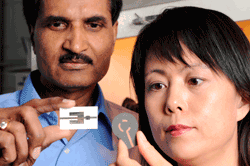Low-cost sensor detects key ingredient in explosives
Researchers at the Georgia Institute of Technology have developed a prototype wireless sensor capable of detecting trace amounts of ammonia — a key ingredient of many explosives. The device, which employs carbon nanotubes and is printed on paper or paper-like material using standard inkjet technology, could be deployed in large numbers to alert authorities to the presence of explosives.
“The prototype incorporates a sensor and a communications device in a small, low-cost package that could operate almost anywhere,” said Krishna Naishadham, a principal research scientist who is leading the work.

Krishna Naishadham, left, and Xiaojuan (Judy) Song display two types of wireless ammonia-sensing prototype devices. (Photo by Gary Meek.)
The wireless component for communicating the sensor information — a resonant lightweight antenna — was printed on photographic paper using inkjet techniques devised by Professor Manos Tentzeris of Georgia Tech’s School of Electrical and Computer Engineering. The inkjet-printed sensing component, based on functionalized carbon nanotubes, has been optimized, fabricated, and tested by Xiaojuan (Judy) Song, a GTRI research scientist.
“This is not the first inkjet-printed ammonia sensor that has been integrated with an antenna on paper,” said Tentzeris. “The fundamental difference is that this new sensor possesses dramatically improved sensitivity.”
Tentzeris explained that the key to printing components, circuits, and antennas lies in novel “inks” that contain silver nanoparticles in an emulsion that can be deposited by the printer at low temperatures — around 100°C. A process called sonication helps to achieve optimal ink viscosity and homogeneity, enabling uniform material deposition and permitting maximum operating effectiveness for paper-based components.
The nanoscale cylindrical structures, about one-billionth of a meter in diameter, are functionalized by coating them with a conductive polymer that attracts ammonia. The sensor has been designed to detect ammonia in trace amounts — as low as 5 ppm, Naishadham said. For more information, see www.gtri.gatech.edu.
Jim Harrison
Advertisement
Learn more about Electronic Products Magazine





